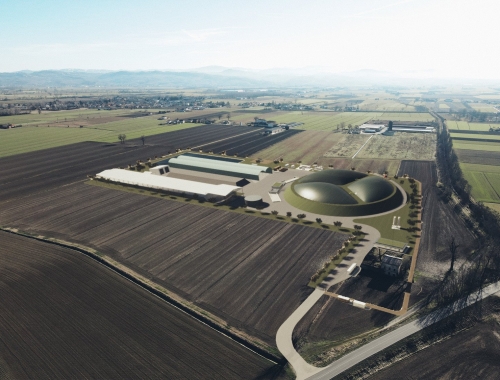An alternative approach for hydrogen
SUMMARY
UK tech startup Levidian is pioneering an alternative method for producing hydrogen that also yields a valuable additional product [Gas in Transition, Volume 2, Issue 5]
By Joseph MurphyPOSTED IN:
While there is a growing consensus that low-carbon hydrogen has an important role to play in the energy transition, the debate over which are the best methods for producing the fuel rages on. This debate has centred on a comparison of green hydrogen, produced from water using electrolysis, powered by renewable energy, and blue hydrogen, which is derived from natural gas via steam reforming, with the resulting CO2 captured. Yet UK tech startup Levidian has pioneered another method, which CEO John Hartley believes has a competitive edge over the alternatives both in terms of economics and decarbonisation.
Established in 2012, Levidian has developed LOOP devices that use electromagnetic waves to ionise methane into plasma. The resulting products are hydrogen and graphene, a high-value commodity in industry. These LOOP devices are modular, and small enough to fit in shipping containers, making them easily transportable. And they can easily be hooked up to existing natural gas infrastructure.
To date, policymakers in the UK and elsewhere have mostly focused on the decarbonisation of the electricity system, “whereas the decarbonisation of heat, where hydrogen really is at the core, has been somewhat neglected,” Hartley tells NGW.
“But that’s changing now,” he says. “Now that we have made big strides in the decarbonisation of electricity, the focus is on deeper decarbonisation, of energy-intensive industry.”
Levidian’s process does not easily fit into the hydrogen colour categorisation, although it might be considered as “turquoise” hydrogen.
“The colour coding can be useful so people understand on a basic level that there are different ways of producing hydrogen, but often there’s so much nuance around how that works, that the coding can be a bit misleading,” Hartley says.
Rather, he wants to see classification of hydrogen based on the carbon footprint rather than the method in the future.

There are a number of advantages that Levidian’s process has over the alternatives, according to Hartley.
Unlike other methane cracking processes, LOOP does not apply heat or use any catalysts to work. It also requires less electricity than electrolysis, The process also requires less water than blue and green hydrogen production. And when waste gas is used as feedstock, preventing it from leaking into the atmosphere, the resulting hydrogen can have a lower carbon footprint than green hydrogen.
“Green hydrogen can get close to net zero but it will never quite get there,” Hartley explains. “Our product can have negative emissions.”
Graphene
Meanwhile, whereas blue hydrogen production produces gaseous carbon that must be captured and safely stored at cost, Levidian’s process produces graphene, a highly valuable commodity with a range of industrial applications. For example, it can be used in the production of rubber for tyres and building materials, including cement and concrete, to make them more durable. Making products last longer also has a follow-on benefit in terms of carbon footprint.
“What we've been doing is to lock carbon into a graphene material that has a very high commercial value and which you can embed it in other materials to make them long-lasting,” Hartley says. “It’s about building a circular economy.”
The sale of the graphene covers most of the input costs for electricity and methane, but the market for the product needs to be scaled up.
“At certain sites we can potentially give the hydrogen to the customer at no cost, as long as we have a guaranteed market and price for the graphene,” Hartley says. “And that’s where scale becomes really important. If you have a scalable market for the graphene, you can produce more and more hydrogen and drive down the cost even further.”
Partnerships
Levidian has already forged several partnerships to help grow its business. It partnered with UK gas and power infrastructure operator National Grid to trial its technology in late January. During the trial this year, Leviadian’s LOOP process will take 1.5 m3/hour of gas from the UK grid and produce 7 kg/day of hydrogen. The graphene can then be used by National Grid as a corrosion-resistant internal coating for gas pipelines, which in turn makes them more suitable for transporting hydrogen.
In January, industry body Energy Networks Association (ENA) said upgrades would prepare the UK gas grid to receive blends of up to 20% hydrogen from 2023.
In early May, Levidian teamed up with yacht brokerage Edmiston to support the decarbonisation of the yacht sector, by using graphene for battery technologies, paints and coatings and desalination systems.
Levidian then announced a major breakthrough on May 16, sealing a £700mn ($874mn) deal with Zero Carbon Ventures to decarbonise gas flaring and landfill sites in the UAE using its technology. Under the agreement with Zero Carbon Ventures, Levidian will deploy 500 of its LOOP50 systems over the next five years.
A single one of these systems will avoid 100 metric tons of CO2 equivalent annually by using waste gas to produce hydrogen and graphene. Overall, they will prevent 500,000 mt of CO2 equivalent over a 10-year period, Levidian said.
The company will also deploy the first LOOP10 system at a site in Abu Dhabi owned by local energy company IDC.
“We’ve proven the technology so for us, it’s all about scale and deployment over the next two years,” Hartley says. “We’re focused on finding as many offtakers for the graphene as possible, and we want those graphene applications to help other industries decarbonise.”
This feature was originally published in Gas in Transition, the monthly magazine of NGW.







